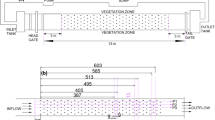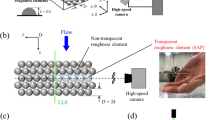Abstract
Diffusion coefficient of natural sediments and effects of lift force and gradient in particle velocity fluctuations were investigated through using a closed kinetic model. Comparison against experimental data of Einstein & Chien (1955) validated the model. The diffusion coefficient εyy of medium and large sediments distinctly exceeds fluid eddy viscosityv tf , while εyy of fine sediments approximately equalsv tf . In the measured region of0.03<y/H<0.4, ε yy/v tf increases with the distance from the wall decreasing. Combined effects of lift force and gradient in particle velocity fluctuations change sediment gravitational settling remarkably belowy/H=0.2, and need to be accounted for describing sediment diffusion in this region.
Similar content being viewed by others
References
Chien, N., Wan, Z. H., Mechanics of Sediment Transport (in Chinese), Beijing: Science Press, 1983.
Van Rijn, L. C., Sediment transport, II: Suspended load transport, J. Hydr. Eng., ASCE, 1984, 110(11): 1613–1641.
Ni, J. R., Wang, G. Q., On the two patterns of vertical distribution of sediment concentration and their formation cause, J. Hydr. Eng. (in Chinese), 1987(7): 60–68
Ni, J. R., Wang, G. Q., Zhang, H. W., Basic Theories of Solid-liquid Two-phase Flow and Their Recent Applications (in Chinese), Beijing: Science Press, 1991.
Ni, J. R., Wang, G. Q., Vertical sediment distribution, J. Hydr. Eng., ASCE, 1991, 117(9): 1185–1194.
Czernuszenko, W., Drift velocity concept for sediment-laden flows, J. Hydr. Eng., ASCE, 1998, 124(10): 1026–1033.[DOI]
Liu Dayou, A study of sediment transport from the equations of turbulent two-phase flows—A discussion on diffusion theory and diffusion coefficient of sediment, J. Hydr. Eng. (in Chinese), 1995, (4): 62–67.
Wang, G. Q., Ni, J. R., Kinetic theory for particle concentration distribution in two-phase flows, J. Eng. Mech., ASCE, 116(12): 2738–2748.
Ni, J. R., Wang, G. Q., Borthwick, A. G. L., Kinetic theory for particles in dilute and dense solid-liquid flows, J. Hydr. Eng., ASCE, 2000, 126(12): 893–903.
Fu, X. D., Wang, G. Q., Analysis of vertical distribution of suspended sediment using the PDF equation method, Acta Mechanica Sinica (in Chinese), 2003, 35(4): 393–400.
Zaichik, L. I., Pershukov, V. A., Kozelev, M. V. et al., Modeling of dynamics, heat transfer, and combustion in two-phase turbulent flows, Part I: Isothermal flows, Experimental Thermal and Fluid Science, 1997, 15: 291–310.[DOI]
Xu, Y., Zhou, L. X., A second-order moment two-phase turbulence model based on the Lagrangian PDF, Chinese J. Comput Phys. (in Chinese), 2000, 17(6): 633–640.
Fu, X. D., Wang, G. Q., Kinetic model of particulate phase in dilute solid-liquid two-phase flows, Acta Mechanica Sinica (in Chinese), 2003, 35(6): 650–659.
Kallio, G. A., Reeks, M. W., A numerical simulation of particle deposition in turbulent boundary layers, Int. J. Multiphase Flow, 1989, 15(3): 433–446.[DOI]
McLaughlin, J. B., Numerical computation of particles-turbulence interaction, Int. J. Multiphase Flow, 1994, 20(suppl.): 211–232.[DOI]
Lataste, J., Huilier, D., Burnage, H. et al., On the shear lift force acting on heavy particles in a turbulent boundary layer, Atmospheric Environment, 2000, 34: 3963–3971.[DOI]
Einstein, H. A., Chien, N., Effects of heavy sediment concentration near the bed on velocity and sediment distribution, Univ. of Cal., Berkeley, and US Army Corps of Engr, Missouri River Div, Rept No. 8, 1955.
Nezu, I., Rodi, W., Open-channel flow measurements with a laser Doppler anemometer, J. Hydr. Eng., 1986, 112(5): 335–355.
Young, J., Leeming, A., Atheory of particle deposition in turbulent pipe flow, J. Fluid Mech., 1997, 340: 129–159.[DOI]
Jenkins, J. T., Boundary conditions for rapid granular flows: Flat frictional walls, J. Appl. Mech., ASME, 1992, 59: 120–127.
Fu, X. D., Wang, G. Q., Dong, Z. N., Theoretical analysis and numerical computation of dilute solid/liquid two-phase pipe flow, Science in China, Ser. E, 2001, 44(3), 298–308.[Abstract] [PDF]
Armenio, V., Fiorotto, V., The importance of the forces acting on particles in turbulent flows, Phys. Fluids, 2001, 13(8): 2437–2440.[DOI]
Author information
Authors and Affiliations
Corresponding author
About this article
Cite this article
Wang, G., Fu, X. Mechanisms of particle vertical diffusion in sediment-laden flows. Chin. Sci. Bull. 49, 1086–1090 (2004). https://doi.org/10.1007/BF03184041
Received:
Accepted:
Issue Date:
DOI: https://doi.org/10.1007/BF03184041




